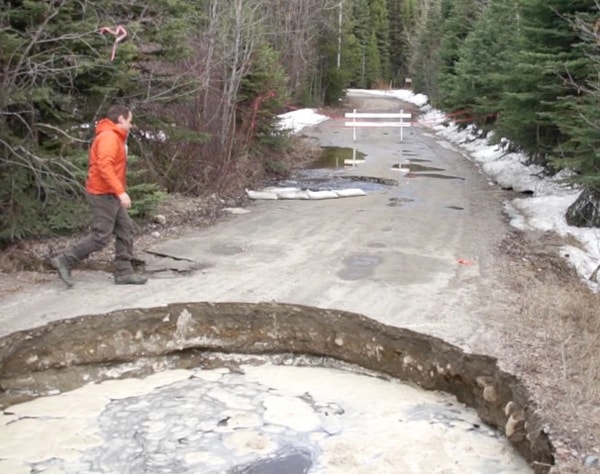Nearly three months have passed since the threat of a flash flood forced people from their homes downstream of Chute Lake.
The evacuation began at 2 p.m. on April 27 after the outflow from the freshet-swollen lake overwhelmed culverts that were supposed to carry water under the Elinor Forest Service Road and into Chute Creek. The water instead backed up against the side of the road, which then became a sinkhole-ridden dam.
The flood threat, reported that morning by a road maintenance worker, was tamed though, and the evacuation order for a large area north of Naramata lifted after just 26 hours.
“There was definitely a risk of losing that road. That 15-foot sinkhole probably had two to three feet on either side of it. And if you would have lost that... that’s a lot of water going down that slope,” Ken Cunningham said in an interview last week.
Cunningham is the area resource manager for the Ministry of Forests, Lands and Natural Resource Operations, and helped co-ordinate the response of the provincial government, which has jurisdiction of the road.
Debriefing notes obtained by the Western News show Cunningham and his team were pleased with the outcome, although they did encounter some problems, including misinformation in the media.
Initial reports from some local and provincial media outlets, the Western News included, mistakenly suggested the flood threat had been created by the possibility of a breach of the privately owned dam at the south end of Chute Lake.
“There was nothing wrong with the dam,” Cunningham said, because it’s designed to be over-topped when the lake reaches a desired level.
After the Testalinden Dam failure near Oliver in 2010, “there has been a lot of sensitivity around dams and we didn’t want to say this was another dam concern,” Cunningham said.
He allowed, though, that his office “could have given more accurate and timely updates for the media.”
The debriefing notes also reveal the ministry had an abundance of rented equipment — including seven dump trucks and three excavators — at the ready to clear debris from Chute Creek and re-establish road crossings had the flash flood materialized.
But just two excavators and dump trucks were needed for the job of removing the culverts and digging up the road to release pent-up water.
Cunningham said the equipment rental bill totalled around $18,000, but it was a reasonable cost: “You don’t want to have something go wrong and then start phoning around.”
Also on standby were two rescue boats manned by personnel from fire departments in Naramata and Penticton.
“If something was to have let loose, we would have (had) something there to assist with,” explained Naramata Fire Chief Will McCutcheon.
He said the boats were staged on Okanagan Lake and could have been pressed into service if evacuees or emergency personnel needed rescue off the beach, or to ferry people around a debris field or road wash-out.
The fire hall itself was pressed into service as the emergency check-in centre for evacuees; just 12 families from the 47 homes in the evacuation zone registered in the first eight hours after the order was issued.
“It makes it difficult for us as emergency responders,” said Dale Kronebusch, emergency services supervisor for the Regional District of Okanagan-Similkameen, the local government responsible for the evacuation.
“It’s just so we know who’s out of the area and how we can contact them should we need to give them information,” Kronebusch said. “They don’t have to be looking for hand-outs, they don’t have to be looking for anything other than information.”
Elsewhere in the region, the RDOS was dealing that same weekend with flooding around Otter Lake that saw water touch a third of the homes in Tulameen, and an emerging threat from Shuttleworth Creek near Okanagan Falls.
Cunningham and his crew, meanwhile, were dealing with a big spring freshet that was hastened by a week of hot weather followed by torrential rain. But the problem at Chute Lake was not entirely unforeseen.
One of Cunningham’s men wrote in his debriefing note that the issue at the Elinor FSR also appeared in 2011.
Cunningham said it was reported at the time that water was lapping over top of the road, but not causing any damage, so ministry staff planned to assess the site later for a new crossing.
Since part of the road is now decommissioned, there are no immediate plans to replace the crossing, Cunningham said, because there is still another route around the south end Chute Lake.
